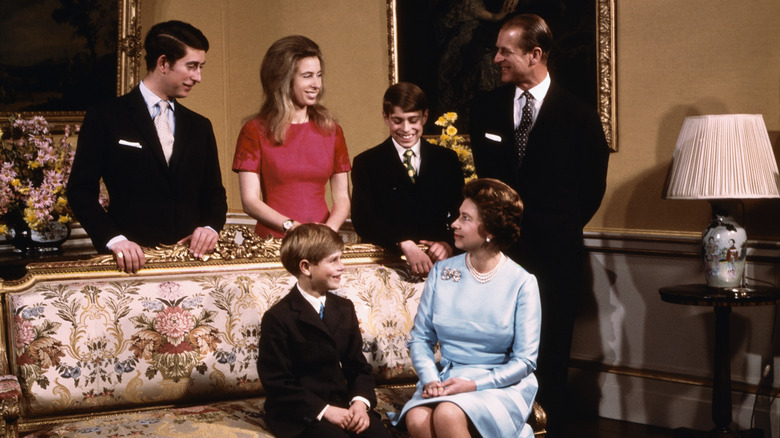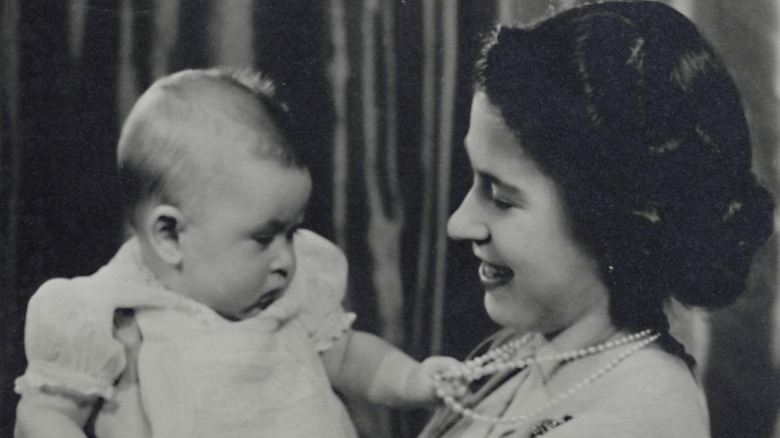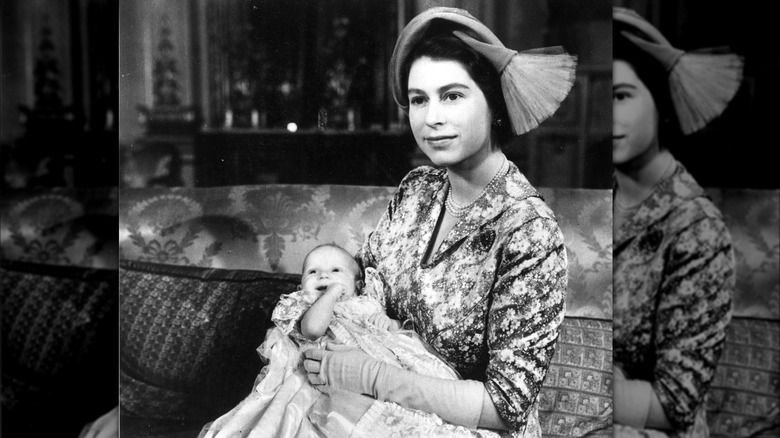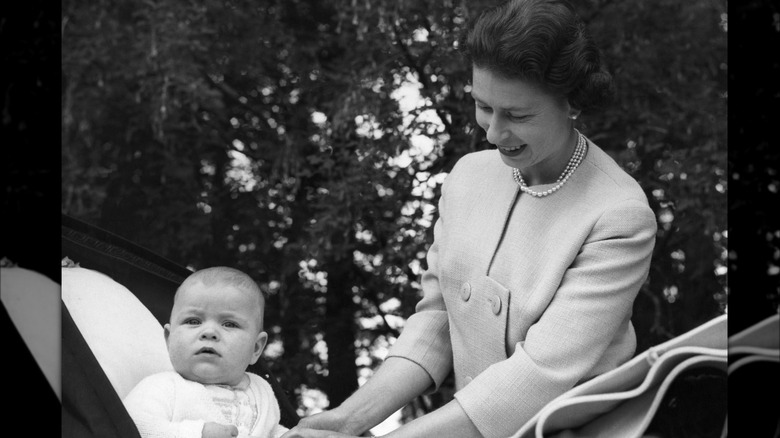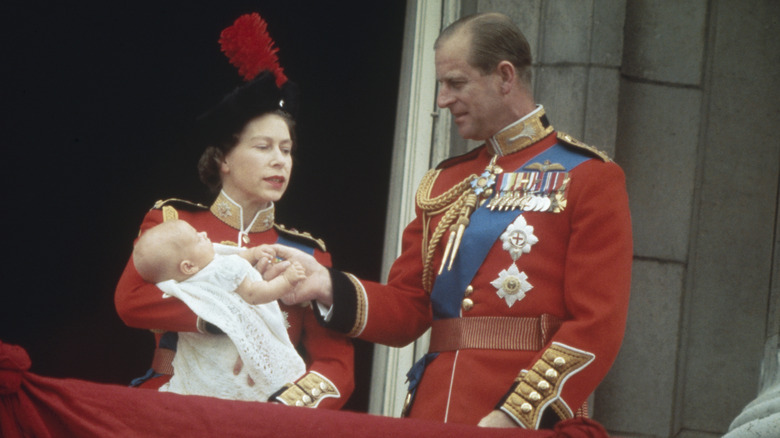What The Royal Births Of The Queen's Four Children Were Really Like
Queen Elizabeth gave birth to four children over a period of over 15 years. However, it's unlikely that anyone would have heard the monarch refer to herself as pregnant during that time. The late queen apparently disliked the term. Instead, she preferred to say "in the family way," according to a palace source who spoke to Us Weekly.
Elizabeth kept her pregnancies as private as possible. In recent times, royals like Catherine, Princess of Wales, have announced their pregnancies via social media platforms like Twitter. In contrast, when Elizabeth was pregnant with King Charles, Buckingham Palace issued an ambiguous statement that she wouldn't make any public appearances for a while. Later, when she was pregnant with Prince Andrew, the palace's announcement of a break from duties and a postponed royal tour proved a PR boon, as it dispelled stories of marital strife between the queen and Prince Philip.
In addition, unlike Kate's stunning pregnancy style, the queen's fashion choices were intended to disguise her maternity. Once clothing could no longer conceal her bump, she paused her royal appearances and worked from home. Home was also the place where the monarch gave birth, too. Elizabeth placed being a mother as more important than her royal responsibilities, having reportedly called motherhood "the only job which matters," per Daily Mail.
King Charles was born via C-section
King Charles was born at Buckingham Palace on November 18, 1948, at 9:14 p.m., before Elizabeth became queen. After enduring 30 hours of labor, Elizabeth required a cesarean section. However, there was no need to go to the hospital. The palace had four doctors and the necessary equipment to handle the surgical procedure.
Elizabeth's first birth experience was notable for who it didn't include. Prior to this time, a government representative, frequently the home secretary or prime minister, was on hand to confirm a royal birth. However, Elizabeth's father, King George VI, wanted to ditch this practice. "He said, 'Even though she's giving birth to the heir of the throne, we are not going to have this witness,'" Kate Williams, a royal historian, explained to 5 News, per British Heritage.
Unlike the home secretary, Prince Philip's absence was not unusual. As was typical of the time, Philip wasn't with his wife, although he was anxiously waiting for news. Finally, palace staff proposed a game of squash to pass the time. As soon as Charles was born, Philip rushed in to meet him. Philip's first impression was that his new son "looked like a plum pudding," per Daily Mail. As they settled in as a new family of three, Elizabeth breastfed Charles for his first month, and Philip enjoyed carrying him around. "[Philip] adores children and also small babies," Marina, Duchess of Kent and Philip's cousin, divulged at the time.
Princess Anne weighed six pounds, precisely
By the time her second baby was due, Queen Elizabeth, King Charles, and Prince Philip were all living at Clarence House, so it was logical for her to give birth to Princess Anne there. Anne was born at 11:50 a.m. on August 15, 1950, weighing six pounds.
Despite Elizabeth's tradition of not announcing her pregnancies, the public must have figured out that a hiatus from royal appearances equaled a royal baby on the way. Around the time of Anne's birth, a newsreel captured footage of crowds waiting outside the then-Princess Elizabeth's home for news of the baby's arrival. While royal fans could read the news of Anne's birth outside Clarence House, it took two weeks until the little princess' name was released to the public.
Like at Charles' birth, neither Philip nor the home secretary were present. Philip was delighted with his daughter's arrival, foreshadowing a close relationship between Philip and Anne. "It's the sweetest girl," he commented as he shared the news of Anne's birth, per Daily Mail. It was a landmark day for the Duke of Edinburgh, as Philip scored a naval promotion, command of his own ship, and became a new dad-of-two. Amid the day's joy, Philip invited his staff to join him in raising a glass of champagne to celebrate.
Prince Andrew's birth had worrisome side effects
Queen Elizabeth's third child, Prince Andrew, was born at 3:30 p.m. on February 19, 1960, and weighed seven pounds, three ounces. Like King Charles, Andrew was born at Buckingham Palace, the family's main residence after Elizabeth became queen in 1952. Although there's nearly a ten-year gap between Anne and Andrew's births, the experience was similar. For her first three births, Elizabeth was given morphine and scopolamine as part of a procedure called "Dammerschlaf" or "twilight sleep," per The Mirror. These drugs were intended to help women avoid remembering the pain of childbirth and often required forceps for the delivery.
Mothers and babies were impacted by the drugs. In Elizabeth's case, one of her ladies-in-waiting detailed that the queen experienced "post-natal side effects" after Andrew's birth, according to Gyles Brandreth's book, "Elizabeth." All things considered, the queen was comparatively fortunate as a mistake in the amount of the drugs administered could be fatal for mothers.
Like with Charles and Anne, Prince Philip wasn't present for Andrew's birth. In addition, he was considerably less anxious and less excited by Andrew's arrival. "If a third comes along, they accept it as natural, even if they haven't gone out of their way for it," Philip said, according to Ingrid Seward's book "Sarah, HRH The Duchess of York," per Express. In contrast, for the queen, after three births, she felt more confident as a mother, and Elizabeth and Andrew formed a tight bond.
Queen Elizabeth embraced new birthing philosophies with Prince Edward
Queen Elizabeth's youngest child, Prince Edward, was born on March 10, 1964, at 8:20 p.m. at Buckingham Palace. Edward was a little smaller than Princess Anne, weighing five pounds, three ounces. Unlike her previous birth experiences, Elizabeth reportedly opted for an active, alert birth without "twilight sleep" medications.
The queen had been reading up on the latest birthing philosophies and decided it was time to shake up royal tradition. Rather than being elsewhere in the vast palace, Prince Philip was actively involved during Edward's birth — a significant moment in Elizabeth and Philip's long relationship. "The Duke of Edinburgh was actually holding his wife's hand as their youngest was born," Ingrid Seward writes in "My Husband and I." "She'd been keenly reading women's magazines that stressed the importance of involving fathers in childbirth and had become fascinated by the idea." Philip and Edward enjoyed a close relationship, possibly fostered by the prince's ability to be present and bond with his youngest child immediately.
Elizabeth also formed a close attachment to Edward. As historian and author Robert Lacey informed Town & Country, one of the late queen's friends once observed, "The queen was rather scared of parenting when she started out — she'd not been taught it by her own mother. But as she grew into the job, her successive children helped remove her fears."
